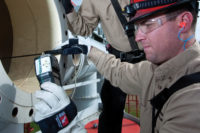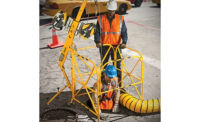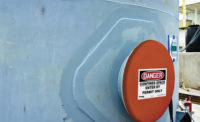The risks of confined space entry can be greatly reduced by following proper protocol and general confined space awareness. In fact, most fatalities in confined spaces are a result of personnel entering the space without a permit, proper ventilation or proper atmospheric monitoring, to expedite work or for rescue purposes.
To protect confined space entrants from potential hazards, OSHA developed a set of standards and directives for confined space entry. These standards are widely accepted as the national protocol, although some U.S. states have adopted their own standards related to confined spaces. (OSHA’s regulations can be found in full at OSHA.gov 29 CFR 1910.146.)
Attendant duties
Arguably, one of the most critical components of OSHA’s confined space entry standards is code 1510 1910.146(i), which requires a confined space attendant. An attendant is the employee who remains outside the confined space and monitors the entrant, guards the space against unauthorized entry, warns the entrants of any unusual conditions and summons rescue personnel if needed. Specifically, an attendant’s responsibilities include:
• Monitoring entrants during the job and during entry and exit to help ensure their safety. The attendant may not abandon his post for any reason while personnel are in the space unless relieved by another qualified attendant.
• Monitoring atmospheric conditions in the space prior to and during entry.
• Controlling access to the confined space.
• Summoning emergency assistance as needed.
• Assessing hazards in and around the space.
• Keeping records of confined space work, such as air test results, personnel entry/exit, etc.
Selecting an attendant
The role of the confined space attendant should not be taken lightly, as their responsibilities can literally save lives. Unfortunately, the person assigned to the role of attendant is often an entry-level employee who has not been properly trained in confined space entry safety. In other cases, a local off-duty fireman or friend of a worker is brought in to serve as the confined space attendant. Even local fireman can pose a risk if not trained in OSHA protocol and confined space procedures.
None of these situations is ideal. In an emergency situation, an untrained attendant is likely to rush into the confined space to help those in trouble, especially if they personally know the entrant. This causes more harm than good and puts two or more people in a dangerous situation. For this reason, confined space deaths are often in multiples of two or higher.
The advantages of having a properly trained attendant are significant. They can review the permit and ensure it is filled out properly. They can review the tasks to be performed and PPE required for the job. They will know that a welder will need a Hot Work Permit in addition to the Confined Space Entry permit, as well as a fire watch and proper fire-suppression equipment. The attendant can also deny access to anyone who does not meet the criteria set forth on the permit, does not have proper PPE or training, is not listed on the entry permit or if there is an atmospheric condition that has changed the classification of the space.
An objective, third-party company — with trained attendees and rescue teams with proper gear — can be brought in to any worksite involving confined space entry. A trained and objective attendant will mandate the proper OSHA procedure. They do not care how much experience the entrant has, even if he is the boss. A third-party attendant will also ensure that all atmospheric testing is complete according to proper protocol, using instruments that they have been fully trained to use. Finally, they will not react emotionally during an emergency situation but will be able to respond according to safest protocol.
A real-life example
Take, for example, an incident narrated to me that occurred in a small refinery on the West Coast over a decade ago. A work crew was completing a complicated and challenging turnaround. The last task was to load the upper half of the sulfur reactor with an alumina-based catalyst. While the reactor was being loaded, it started to rain and the rain was contacting the catalyst and making it wet. One of the workers noticed that the wet catalyst was becoming hot to the touch, even through his protective gear. Someone suggested that the catalyst was experiencing a runaway thermal reaction to the water, and the crew immediately stopped the task.
Supervising personnel decided that the reactor should be closed and the space purged with nitrogen gas. Had the supervisors followed proper OSHA standards and referred to the MSDS for the catalyst, they would have realized that the wet catalyst was warming from a mechanical reaction of the water with the alumina of the catalyst. The MSDS explained that wet catalyst would experience a warming trend, would plateau in temperature and then begin cooling down. There was no runaway thermal reaction.
While waiting for the catalyst temperature to subside, using the nitrogen purge, the loading crew was put to work cleaning the bottom half of the reactor. The upper half of the vessel was separated from the bottom half by a thin steel diaphragm. It should be noted that tests were not conducted along the seam of the diaphragm to determine if the structure was leaking nitrogen from the chamber above.
Had someone taken the time to review the as-built blueprint for the reactor, the employees would have realized that they were putting a 12-pound nitrogen system into a chamber that had a maximum internal pressure of eight pounds. As the six workers in the lower chamber continued to work, the pressure in the upper chamber continued to increase. Approximately 45 minutes later, the diaphragm — straining from the building nitrogen pressure — experienced an explosive failure. The diaphragm separated from the walls of the reactor and crashed down onto the workers below.
Miraculously, all but one of the six workers escaped the lower chamber. The sixth employee was killed by massive blunt trauma to the head and upper torso. The confined space attendant was caught in the releasing nitrogen pressure and was pushed through the guardrail of the walkway he was standing on. He was killed instantly.
In addition to the tragic loss of life, the facility suffered a huge setback in the completion of the turnaround. The vessel was seized by OSHA and was cut in half, and the replacement vessel took three months to arrive. Litigation surrounding this incident continued for several years after the event. The total cost to the facility was never revealed.
In reviewing the facts of this tragic incident, it is clear that the on-site confined space attendant failed to follow proper protocol. The attendant did not force the management to read MSDS sheets, as outlined by OSHA standards, or ensure that they examined the “as built” documents before implementing a procedure. Had the confined space attendant been cross-trained and objectively stated proper procedure, multiple deaths — including his own — could have been prevented.
Third-party attendants
In many industries, confined space entry is a routine part of the job. In others, it may only be an occasional necessity. Sadly, bid awards for confined space attendants are not based upon the training and skill development of these professionals, but on those who are the lowest paid. As a result, recruiting and competency in this trade wanes; and so follows the level of safety. Furthermore, employers should include attendant personnel in regular safety training and objectively evaluate their competencies at least annually.
Confined space attendants can go a long way toward increasing the overall safety of a workspace, but they are most effective when they are well trained and do not have personal ties to the entrant.



